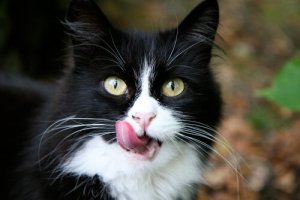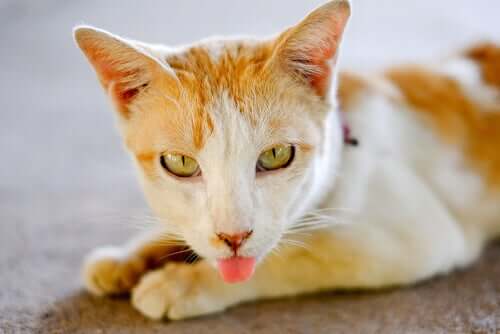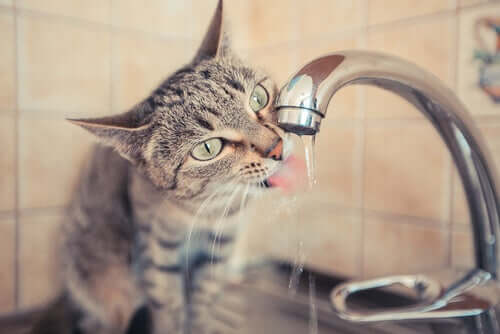The Reasons Why Cats Have Rough Tongues


Written and verified by the lawyer Francisco María García
Cats are enigmatic animals, partly due to their appearance and movements, and partly due to their great skills. One of the many mysteries surrounding them is just why cats have rough tongues.
Cats only lick the people they love very much, unlike dogs. Of course, when they lick you, you immediately feel the roughness of their tongues.
Why do cats have rough tongues? Does this have a special function or is it just a fluke of nature? What would happen if cats didn’t have rough tongues?
Rough tongues in cats
At first glance, it would seem that cats’ tongues are full of hair. They look like thick filaments along the entire muscle. However, these filaments aren’t hair but more complex formations.

These bumps are their taste buds, and they have many peculiarities. They’re made of keratin, the same substance found in human nails. It’s a strong, yet flexible material. These filaments are what make cats’ tongues rough.
Cats’ taste buds are completely different from those of humans, and even very different from those of other animals. In addition to the strange texture, these buds are shaped like cones. More precisely, they look like hooks.
Experts say that they’re very similar to shark teeth. And, just like in sharks, they’re really strong. That’s why when you get licked by a cat, you feel like they dragged sandpaper across your skin.
Why cats have rough tongues
Another reason why cat tongues are so rough is so that they can use them to groom themselves.
Their tongues work very similarly to a brush. With it, they remove any impurities found in their hair. They don’t do it out of sheer vanity; there are strong genetic reasons for this action.
Cats’ hunter nature
Cats, like all other felines, are hunters and predators. It’s in their nature to go after prey they can feed themselves with. They’re genetically predisposed to hunting since the moment they’re born.
By obsessively grooming themselves, what they’re actually doing is eliminating any traces of natural oils from their skin. Cats have their own tastes and don’t want to be detected by their scent. This is part of their hunting mechanism. When hunting, they want to go unnoticed and they don’t want their scent giving them away.
The keratin filaments also play another role. They help cats hold their prey while hunting. They unravel and trap them, so to speak.
A piece of engineering
Cats’ tongues aren’t only an extraordinary comb, but also a fabulous piece of engineering. This is because cats drink liquids without making a sound and in record time. That makes them look very elegant.
Cats have to fight the force of gravity to incorporate a liquid into their throat. Also, they must swallow the water without closing their jaw. Thanks to an extraordinary genetic predisposition, cats have learned to calculate the height at which they can overcome the force of gravity that would prevent the access of a liquid to their snouts.
When cats drink water
To swallow water, cats bend their tongues down. This body forms a high arch, making a sort of letter “v”. It’s a kind of straw. The cat just touches the liquid with its tongue and begins to suck it at an amazing speed.

The liquid attaches itself to their tongues thanks to the action of different forces. One of these is gravity. The other forces are inertia and the attraction that the water molecules and the cat’s tongue exert on each other. Nature gives us a lesson in physics when we look at cats’ amazing tongues.
Cats are enigmatic animals, partly due to their appearance and movements, and partly due to their great skills. One of the many mysteries surrounding them is just why cats have rough tongues.
Cats only lick the people they love very much, unlike dogs. Of course, when they lick you, you immediately feel the roughness of their tongues.
Why do cats have rough tongues? Does this have a special function or is it just a fluke of nature? What would happen if cats didn’t have rough tongues?
Rough tongues in cats
At first glance, it would seem that cats’ tongues are full of hair. They look like thick filaments along the entire muscle. However, these filaments aren’t hair but more complex formations.

These bumps are their taste buds, and they have many peculiarities. They’re made of keratin, the same substance found in human nails. It’s a strong, yet flexible material. These filaments are what make cats’ tongues rough.
Cats’ taste buds are completely different from those of humans, and even very different from those of other animals. In addition to the strange texture, these buds are shaped like cones. More precisely, they look like hooks.
Experts say that they’re very similar to shark teeth. And, just like in sharks, they’re really strong. That’s why when you get licked by a cat, you feel like they dragged sandpaper across your skin.
Why cats have rough tongues
Another reason why cat tongues are so rough is so that they can use them to groom themselves.
Their tongues work very similarly to a brush. With it, they remove any impurities found in their hair. They don’t do it out of sheer vanity; there are strong genetic reasons for this action.
Cats’ hunter nature
Cats, like all other felines, are hunters and predators. It’s in their nature to go after prey they can feed themselves with. They’re genetically predisposed to hunting since the moment they’re born.
By obsessively grooming themselves, what they’re actually doing is eliminating any traces of natural oils from their skin. Cats have their own tastes and don’t want to be detected by their scent. This is part of their hunting mechanism. When hunting, they want to go unnoticed and they don’t want their scent giving them away.
The keratin filaments also play another role. They help cats hold their prey while hunting. They unravel and trap them, so to speak.
A piece of engineering
Cats’ tongues aren’t only an extraordinary comb, but also a fabulous piece of engineering. This is because cats drink liquids without making a sound and in record time. That makes them look very elegant.
Cats have to fight the force of gravity to incorporate a liquid into their throat. Also, they must swallow the water without closing their jaw. Thanks to an extraordinary genetic predisposition, cats have learned to calculate the height at which they can overcome the force of gravity that would prevent the access of a liquid to their snouts.
When cats drink water
To swallow water, cats bend their tongues down. This body forms a high arch, making a sort of letter “v”. It’s a kind of straw. The cat just touches the liquid with its tongue and begins to suck it at an amazing speed.

The liquid attaches itself to their tongues thanks to the action of different forces. One of these is gravity. The other forces are inertia and the attraction that the water molecules and the cat’s tongue exert on each other. Nature gives us a lesson in physics when we look at cats’ amazing tongues.
This text is provided for informational purposes only and does not replace consultation with a professional. If in doubt, consult your specialist.








